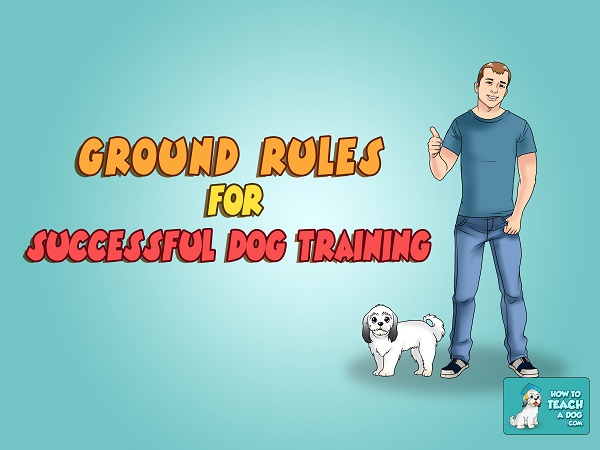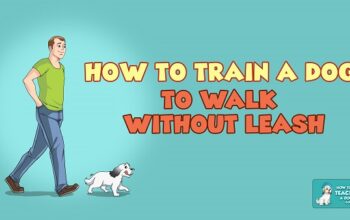
There are several things to keep in mind that will help insure success in your dog training regimen. You need to expect your dog to participate in the learning process, but you don’t want it to be so difficult for him that he can’t succeed. Take your time, and learn to communicate effectively with your dog. Use rewards to reinforce behaviors you like, and design a training program that works best for your individual dog.
1. Let your dog do the thinking. Often we want to help our dogs a little too much. The struggle to figure something out for oneself promotes learning, while spoon feeding information does not. Your dog will actually learn faster if you take the time to allow him to figure out what you are looking for. Some dog trainers use a process we call molding. If I were to mold a sit, I would place one hand under the dog’s chin, and the other behind his back legs, and scoop him into a sit position. I would then reward him for sitting. But truthfully, the dog did absolutely nothing. He certainly isn’t thinking, and while this method may eventually work, the actual learning takes much longer to take hold, and can be easily forgotten if not practiced daily. This is a very inefficient way to train your dog. To allow your dog to think, you need to let him know he can earn a reward, but then allow him to experiment on how exactly to do that. When he guesses the right behavior, give him the reward. Now your dog has actually participated in the learning process, and he will not only learn more quickly, but remember better.
2. Don’t rush the process. Every dog learns at a different rate. Allow your dog to learn at his own rate, and don’t become frustrated. Don’t be tempted to compare your dog with other dogs in your obedience group, or with dogs you have had in the past. He is an individual. Allow him the time to figure the lesson out on his own so that the learning process will take place. If you find that your dog is not “getting it”, take a step back in the process to the last step where he was successful, and gradually work back up to your goal. In dog training we want the dog to succeed, which means we don’t ask him to do more than he is ready to do.
3. Reward behaviors you like in a timely fashion. The best way to do this is with what we call “marker training”. Just as Pavlov was able to get his dogs to salivate at the sound of a bell rung just prior to their food being placed in front of them, we can use a noise that creates a pleasant physiological reaction in dogs because it is always followed by a reward. When the dog hears the noise, he knows he has earned a reward without having to see the reward. The marker can be verbal (“Yes!” or “Good!” are some I might use) or click (which can be made with your mouth, or with a small device known as clicker) and should take place at the exact moment he is doing the behavior, and then the treat comes out. Just be careful not to mark late. If you mark after the dog has moved on to a new behavior he will think he is being rewarded for something different than he actually is. The treat can follow the behavior, but the verbal marker or click must be right on time!
Don’t expect your dog to speak English until you teach him. It is useless to say “sit” to a dog that doesn’t know how to sit for you first. Teach him that you like sit, then teach him that the behavior is called “sit”. How often do you tell your dog “No” but he doesn’t change his behavior in any way? Just like “sit”, your dog needs to learn what “no” means if you are going to use it effectively.
4. Pay attention to your dog’s body language. If your dog becomes stress, he will use his body to tell you that he doesn’t understand the lesson. If he begins showing body language that indicates he is stressed, make sure you are not the source of his stress by taking a deep breath, getting rid of any frustration you might be having, and ask him to do something he knows well. When he does, reward him copiously. Training should be fun for both you and your dog. He will learn much more that way. Here are a few things to watch for:
• Tongue flicking (quickly flicking his tongue up to his nose, usually repeatedly)
• Yawning
• Panting when it isn’t hot
• Turning his back on you and sitting down
• Sniffing the ground
• Laying down
• Freezing
If it seems like your dog has disengaged from training, take a break. When you come back, make things easier and more fun. Increase the value of your treats. Your job is to help him succeed.
5. Learn what your dog finds rewarding. Most dogs find food rewarding, but not all dogs do. And some dogs can be pickier about food than others. If your dog will work enthusiastically for his kibble, then you can use the kibble to train. But if your dog isn’t interested in working for kibble you may need to get some treats. If he doesn’t like treats, you may need to break out the chicken. There are dogs that don’t want to work for food, but will work for play. And rarely do you find that a dog works for praise and affection. Whatever your dog finds rewarding is what you use.
6. Reward behaviors you like and ignore behaviors you don’t. Any behavior you reward will become stronger. Use this to build your dog’s behavioral repertoire until you have tools you can use to replace unwanted behaviors. Don’t reward the unwanted behaviors. You may be rewarding them without even realizing it. Dogs, like children, will settle for negative attention if that’s what is available. A dog jumps on his owner for attention. If the owner shouts at the dog, knees the dog, or even looks at the dog in response, the dog has gained his reward for jumping. But if the dog’s owner acts like the dog ceases to exist (no eye contact, no verbal communication, no touch) then there is no reward for jumping. If I receive a reward for sitting, but not for jumping, and you tell me to sit in situations where I might jump, I will eventually learn to sit for attention.
7. Avoid punishment. The trick to successful training is to teach your dog what you want him to do rather than teaching him what you don’t want him to do. Imagine this in the context of raising children. If you tell your child not to jump on the bed, they may very well go and jump on the couch. But if you tell your child to go and ride his bicycle you have given him something to do that excludes jumping on the bed. Punishment does not teach your dog what you want him to do. He is left to his own devices to figure that out. Punishment may suppress unwanted behavior, but it is often temporary, and often comes with unintended consequences. Dogs who are punished often may resort to aggression either to the person who is punishing them or to someone who just happens to be present at the time in an attempt to make the punishment stop, or they may simply stop working because they cannot figure out how to avoid the punishment. Punishment should never be used to try to teach behaviors. Punishment by definition always reduces a behavior, it never makes any behavior stronger. Only rewards make behaviors stronger.
8. Practice often and keep your training sessions brief. Most dogs have a short attention span. Instead of trying to work with your dog for several hours at a time, try breaking the training sessions up into several short intervals done throughout the day.
Following these eight rules will greatly increase the effectiveness of your training sessions with your dog. Keep in mind that your dog is an individual, and that training needs to be tailored to his needs and done in a way that he can understand. Be kind and be patient. Before you know it your dog will be amazing your friends with his new skills!


